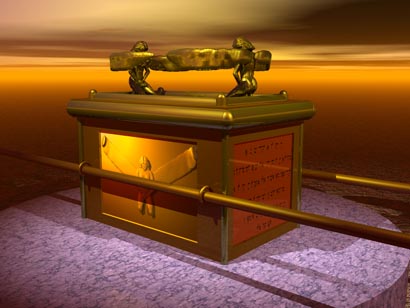What Happened to the "Lost" Ark?
In the popular motion picture,Raiders of the Lost Ark, a tenacious archeologist fights Nazi's, corrupt competitors, and snakes to obtain the "one true Ark of the Covenant." The film is a classic fictional action-adventure, but it left some of the audience asking these questions: What is an Ark of a Covenant and does it have the powers pictured in the movie? What really happened to it?
The story of the Ark starts in the Bible. In Exodus 25:10 after the Hebrews had left Egypt God gave instructions to Moses regarding the building of the Ark:
Have them make a chest of acacia wood - two and a half cubits long, a cubit and a half wide, and a cubit and a half high. Overlay it with pure gold, both inside and out, and make a gold molding around it. Cast four gold rings for it and fasten them to its four feet, with two rings on one side and two rings on the other. Then make poles of acacia wood and overlay them with gold. Insert the poles into the rings on the sides of the chest to carry it. The poles are to remain in the rings of the ark; they are not to be removed.
Nobody today exactly knows what tree "acacia" wood was from (though some speculate it may have been cedar) but the instructions clearly command that it be used to build a box which in modern measurements would be 3 feet 9 inches long and 2 feet 3 inches wide by 2 feet 3 inches deep. Poles were slid through rings on each side of the ark so that it could be carried from place to place by the priests. In a separate passage instructions were given for the construction of the lid of the ark known as the "mercy seat:"
Make an atonement cover of pure gold - two and a half cubits long and a cubit and a half wide. And make two cherubim out of hammered gold at the ends of the cover. Make one cherub on one and and the second cherub on the other; make the cherubim of one piece with the cover, at the two ends. The cherubim are to have their wings spread upward, overshadowing the cover with them. The cherubim are to face each other, looking toward the cover.
While Moses and the Israelites were camped during their exodus from Egypt, the Ark was stored in the traveling tabernacle they had constructed, in a section known as the "Holy of Holies." It was there Moses and the Priests would go to talk with God so that they could be given their instructions. In the Bible God tells Moses:
There above the cover between the two cherubim that are over the ark of the Testimony, I will meet with you and give you all my commands for the Israelites.
Inside the box was storied some of the Israelites' most sacred relics, including the remains of the original stone tablets of the Ten Commandments.
After the Israelites finally settled in their promised land, King David prepared to build a permanent temple to God in Jerusalem. While the ark was being transported to the site, an incident occurred that showed that God's instructions concerning the Ark were not to be taken lightly.
According to scripture, the Ark was only to be carried by Levities (a group of Hebrews set apart as temple workers) using the poles. Instead, King David brought it to Jerusalem on a cart drawn by oxen. According to First Chronicles 13:9:
When they came to the threshing floor of Kidon, Uzzah [who was driving the cart] reached out his hand to steady the ark, because, the oxen stumbled. The Lord's anger burned against Uzzah, and he struck him down because he had put his hand on the ark. So he died there before God.
Though mishandling the ark was dangerous, it also seemed to be the focal point of several miracles that assisted the Israelites in times of need. In Joshua 4 the Bible records that when the priests who were carrying the ark stepped into the Jordan River, it immediately stopped flowing, allowing the Israelites to cross on dry land. Also whenever the ark was carried into battle at God's command, the Israelites prevailed.
Where Did It Go?
So what happened to the incredibly important historical, perhaps even supernatural, object? Nobody knows for sure.

The Dome of the Rock now stands on the Temple Mount where Solomon's Temple, which contained the Ark, once stood.
|
King David's son, King Solomon, installed the ark in the First Temple around 1000 BC. It probably stayed there in the Holy of Holies for many years. In 586 B.C. the city was attacked by the Babylonian emperor Nebuchadnezzar II. He sacked the city and destroyed the Temple. Many of the sacred objects that had been used in the Temple were taken to Babylon as spoils of war. Though the list of items taken by Nebuchadnezzar is extensive, it does not include the ark. This has lead many biblical experts to suggest that the ark must have been taken out of the Temple before the raid. Perhaps it was hidden in a secret safe place by priests fearing Nebuchadnezzar's success in battle.
If it was hidden just before the Babylonian takeover, where would it have been put? Some speculate that the famous box may have never left the the city at all. The temple mount, which still stands in Jerusalem today , is reportedly honeycombed with caves and tunnels. Could it be deep in some cave under the the ancient site of the temple?
Some conservative Jewish groups hope that someday the Temple Mount, now occupied by Moslem structures, will be the site of a third Hebrew Temple that will house a rediscovered Ark. The Moslem The Dome of the Rock, a building which protects the huge boulder which was likely the location of the Holy of Holies in the ancient Hebrew temples (one expert has even located a rectangular impression in the rock where he thinks is where the ark once sat) is located exactly where any new temple would be built. This has lead to friction between the Jewish conservative groups and the Moslem authorities that currently control the Mount.
In 1982 a secret excavation was carried out under the edge of the Mount by the late Rabbi Yehuda Meir Getz. It is rumored that the illegal dig was looking for the Ark of the Covenant. It wasn't found and the dig came to a quick end when Arabs on the Mount heard banging from a cistern under The Dome of the Rock. Though Getz was convinced that the Ark is in an underground chamber near where he was digging, it is unlikely, given the presence of the Moslem temples on top of the mount that further excavations will be permitted in the near future.
An Electrical Ark?
If we don't know where the ark is, can we at least tell something about its powers? In 1999 author Richard Andrews, in an article in the newspaperDaily Mail,speculated that the ark worked as a giant capacitor which could accumulate an electrical charge as it was carried through the desert in the same way a car driven around on a hot day can develop a static charge. Andrews thought that if the Ark developed a powerful enough charge it might explain why people were struck dead by touching it.
"If the Israelites had set out to construct a primitive accumulator, they could hardly have picked a better design than the Ark," Andrews was quoted as saying in the article. Andrews later built a model of the ark. When tested, it did accumulate a charge.
Though Andrews theory is interesting, it doesn't really explain any of the other miracles attributed to the ark. For those, perhaps the only explanation is divine intervention.
|
However, most experts doubt that the ark could be hidden within the Temple Mount. King Herod rebuilt and reshaped much of the Mount in the first century BC and if the ark was there it most likely would have been found and restored to the Temple.
Others have suggested that the ark was taken out of the city before the Babylonians got control and was hidden in the countryside. Some ancient texts suggest this location might be on the east bank of the Jordan near the biblical Mt. Nebo. To some scholars it seems more likely that the ark might be hidden on the Jordan's west bank, perhaps in one of the caves along the Dead Sea near where the Dead Sea scrolls were found. While these seem intriguing possibilities, we know from the biblical account of Nebuchadnezzar's siege that nothing moved in or out of the Jerusalem for 18 months and the people were starving to death. It seems unlikely that the Hebrews could have smuggled the Ark out during that period. If the Ark was in the city when the siege started, than it is likely it was there when it ended.
Could the Ark have left the city before the siege?
The Ethiopian Connection
In 1992 a book entitled, The Sign and the Seal: The Quest for the Lost Ark of the Covenant, Graham Hancock, a British journalist, peruses a different theory about what happened to the Ark. In the book Hancock explores stories from Ethiopia that suggest the ark was brought there in ancient times. Though there are several variations to the tale, the story suggests that the ark was transported to Ethiopia by a man named Menelik. According to Ethiopian tradition, Menelik was the son of King Solomon and the Queen of Sheba. In this tradition Ethiopia is ancient Sheba, though many scholars today identify that land with modern Yemen.
Menelik, says Ethiopian royal chronicles, held onto the ark for safekeeping. Over the centuries it was moved from location to location, but now, suggests Hancock, it might be sitting in the town of Axum at the St. Mary of Zion Chapel. At that location there is a small sanctuary chapel there, only 40 foot square, where the ark is supposedly kept. Hancock visited the site in 1991 and met with a man named Abba Welde Giorgis who was described as "guardian of the ark." Giorgis's duty is a great honor, but it does limit his social life. He is not permitted to leave the sanctuary for the duration of his lifetime appointment.
Giorgis indicated to Hancock that the ark was there, but in accordance with the church's traditions, Hancock was not permitted to see it, nor would Giorgis describe it to him. Other reporters and writers visiting the church since then have gotten similar answers to their questions. So if the ark does rest in Axum, there is no independent proof of it.

No comments:
Post a Comment